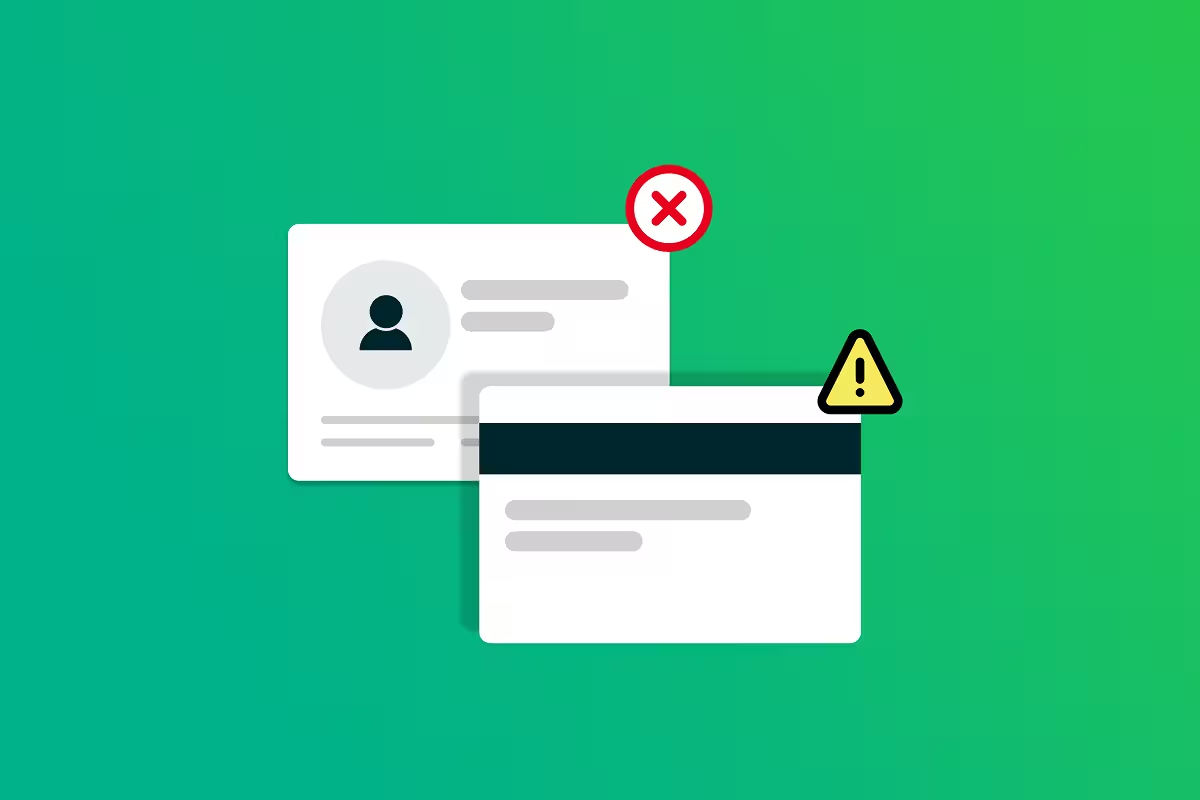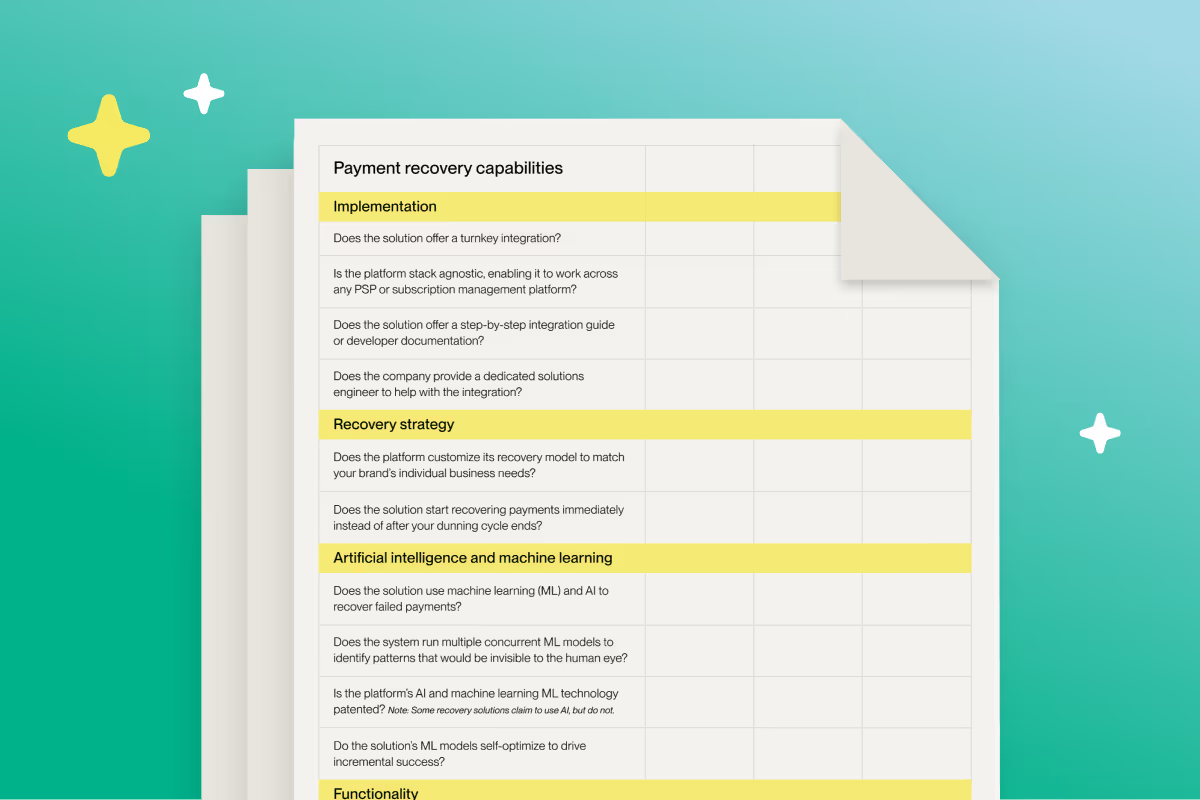
7 ways to end failed payments & maximize recurring revenue
Every 90 seconds, a subscription payment fails, and you lose money. Compounded over a year, fast-growing and established brands stand to lose tens to hundreds of millions of dollars—and the worst part: most payment failures are preventable.
This in-depth guide is designed to give you the context you need to understand the complex world of failed payments and the actionable steps you can take to solve this problem.
When you’re finished, you’ll have the tools you need to boost subscriber retention and surge annual recurring revenue, driving increases of 10%+.
The root of the failed payments problem
Failed payments are like kryptonite for subscriber retention. They steal subscribers every time a payment fails and are the root cause of accidental churn.
What is accidental churn? Also known as passive churn or involuntary churn, it’s when a legitimate payment transaction fails, and the subscriber’s recurring order is canceled—even though they want to stay subscribed.

The impact of accidental churn can’t be understated. It’s estimated that accidental churn accounts for more than 50% of overall churn, equating to a loss of up to 35% of annual revenue and accounting for $440 billion in lost revenue across the industry.
To continue to grow, you must mitigate accidental churn and implement successful strategies to reduce and recover failed payments—it’s the single biggest lever you can pull to drive recurring revenue growth. However, to see optimal results, you should partner with a dedicated machine-learning-powered payment optimization solution like Butter.
1. Analyze your Payment Health
Payment Health is a holistic approach to evaluating the effectiveness and impact of an organization’s entire payment system. Understanding your Payment Health will help you determine if you have a failed payment problem and where to focus your efforts if you do.

Analyze these metrics to determine your Payment Health.
Recurring revenue failures: As the name suggests, this metric examines how much of your revenue fails over a given time period. If more than 2.5% of your total revenue is failing, there is an opportunity to improve your payment process.
Refunds and chargebacks: This metric is an indicator of customer satisfaction and process efficiency. Chargebacks are costly. They damage your Merchant ID (MID), hurting your reputation with banks and payment processors. They also lead to increased fees, slow how quickly you’re paid, and can damage customer relationships. If chargeback rates exceed 0.5%, you should examine your payment processes and your overall retry strategy.
Transaction Authorization Rate: Your authorization rate is the percentage of successful transactions. A first-class authorization rate is between 90-95%. If your rate is lower than 90%, it’s likely banks flagged your business as a potential fraud risk—creating a negative flywheel effect that can lead to more payment failures.
Tracking and optimizing Payment Health leads to increased lifetime value (LTV) and average revenue per user (ARPU), as well as decreased costs, driving exponential ARR gains and higher profit margins.
Request a free Payment Health Analysis
2. Address the most common payment issues
If you’ve determined your payment ecosystem is a “leaky bucket,” start solving the problem by addressing common issues, such as a decline code or fraud.
Decline code
A decline code is a two-digit alphanumeric number that tells you why a payment failed. The codes are typically sent by issuing banks, credit card networks, or payment processors.
While decline codes might sound simple, they’re incredibly complex. Every transaction is associated with 128 data points, and a problem with a single data point can lead to a transaction being declined.
Further complicating the issue is how banks flag declines. Each bank uses unique decline codes, meaning over 2,000 decline codes exist. And, more often than not, a specific decline code is rolled into a related but generalized decline code. As a result, it can be challenging to discover precisely why a subscriber’s transaction failed and know which retry strategy to apply to each decline code.

Cracking the decline code challenge will drive more recurring revenue, but it’s a massive investment in time and resources, especially given the enormity of payment or transaction data to wade through. To tackle on your own, start with your most prevalent decline codes and review patterns within transactions or subscriber segments to understand where to start testing to optimize.
For the best results, businesses should partner with a third-party solution. Butter can quickly decode decline errors with increased granularity and apply nuanced recovery strategies to recover more revenue—typically 70%+ of transactions for 10%+ ARR growth.
Fraud
There are many reasons why a payment might be declined for fraud. The two instances subscription businesses should be most familiar with are failed payments due to card testing and card-not-present (CNP) transactions.
Card testing
Card testing occurs when a fraudster tries to determine if stolen payment information is valid by making small online purchases. What makes card testing so pernicious is that it has an outsized impact on your payment health.
Card testing typically results in numerous failed payments, which damages your reputation with card issuers and networks. As a result, card issuers and networks may believe there is an added risk of working with your company, resulting in legitimate transactions being declined.
Common indicators of card testing are:

To combat card testing, use these three strategies:
- Implement strong authentication measures: For example, use Google reCAPTCHA, which asks users to decipher text or match images.
- Rate limiting: Tailor rate limits to stop the specific type of card testing you're experiencing. As an illustration, you can limit the number of new customers that can be created by a single IP address in one day.
- Machine learning and artificial intelligence-based fraud detection systems: Third-party fraud monitoring tools increase the likelihood of fraud detection while freeing resources.
Card-not-present
Card-not-present (CNP) fraud occurs when someone tries to make a fraudulent credit card transaction without having the physical card at the time of purchase. For example, a fraudster might buy a product online or over the phone using another person’s credit card information.
The best way to prevent CNP is to collect more information about potential customers during checkout. Ask them for the three-digit CVV, expiration date, billing address, and zip code. There are ways to easily capture this information while maintaining or improving checkout conversion via alternate payment methods, allowing users to store credit card data, and vaulting (more on optimizing checkout flows in the next section). Each piece of accurate information you collect increases the likelihood that the transaction is legitimate.
Another way to decrease CNP fraud is by implementing 3-D Secure (3DS). The technology adds another layer of authentication by verifying the cardholder's identity through a process that checks over 100 data points.
4. Use dynamic and data-driven retry logic

A one-size-fits-all approach to solving failed payments doesn’t work. There are too many variables to consider, and the impact on your business can be high. In fact, using a blanket strategy like this, also called a woodpecker approach (a set number of retries on specific dates and times) for retries can create a downward spiral.
We mentioned up top that the more failed payments you receive, the worse your Transaction Authorization Rate, and then most importantly, your Merchant ID (MID), will be. Think of your MID as a credit score. It’s what banks and processors use to rank the trustworthiness of your transactions.
With a low MID, they’ll approach your transactions with more caution, causing more declines. You can prevent this from happening by using the mountain of subscriber data you’re sitting on to develop automated and tailored retry logic.
Collecting and analyzing subscriber data is time-consuming. We recommend subscription businesses work with a failed payment solution provider like Butter that has the capability to swiftly collect and parse payment data, as well as automate retries. Here are a few ways you can use subscriber payment data.
Here are a few ways you can use subscriber payment data.
Implement dynamic decline response handling
There are thousands of decline codes, each of which requires a specific action to resolve. Using your subscriber data, develop retry logic that addresses individual codes.
For example, you can analyze instances in which you successfully recovered a payment associated with an insufficient funds decline and develop an automatic, individualized approach to the error.
Performance-based routing
Many subscription businesses partner with a single payment service provider (PSP). We recommend partnering with several. Not only does this ensure you can always collect payments, but it also gives you the option to retry failed payments on a different PSP (It’s also beneficial for testing and optimizing across global transactions and lowering transaction fees).
This last point is crucial. By collecting and analyzing subscriber data, you’ll know the circumstances in which sending a payment through a different PSP will result in a successful transaction.
Setting up performance-based routing can be challenging, but Butter’s team of payment experts has extensive experience setting up multiple PSPs for leading brands across industries. In addition, Butter’s Route solution dynamically routes payment attempts to varying PSPs and acquirers to optimize for authorization and minimize fees.
Optimize your retry cadence
When it comes to retry cadences, more is not better. Earlier, we talked about batching retries or using a “woodpecker” approach. Simply retrying more times without discerning insights will cost you more and hurt your MID score. (Plus, retries come at a cost for each transaction fee, and you pay for each chargeback.) With a data-driven and dynamic approach, you can optimize your retry cadence to recover more transactions with optimal schedules. This nuanced approach is complex to create manually (128 data points and over 2,00 decline codes). To do it correctly requires a machine-learning-based approach.
5. Automate chargebacks to save time and money
While the terms “chargeback” and “refund” are often used interchangeably, they have specific meanings. A chargeback is a bank-initiated payment reversal on behalf of a cardholder. A refund, on the other hand, is a voluntary, merchant-initiated repayment. Both can profoundly impact your business, but chargebacks pose a greater risk.
Banks monitor chargebacks more closely because they can be an indicator of fraud. Too many chargebacks decrease your merchant reputation, leading to more scrutiny and failed payments. At the same time, businesses can incur fees and penalties for chargebacks on top of losing the product.
Chargebacks can happen for many reasons, including:

When dealing with chargebacks, it’s crucial to focus on non-fraudulent instances. A successful retry strategy considers nuances within your payment data and decline codes (even hard declines can have false positives) and can parse which retries to focus on and which to avoid entirely.
Put yourself in the shoes of someone who had their credit card stolen and had hundreds, perhaps thousands, of dollars charged to their name. You wouldn't want to retry those charges, but how do you know which is which? Fighting these charges creates a negative brand impression on the cardholder and decreases the likelihood they will shop with you in the future.
We recommend brands invest in a solution like Butter to handle and retry chargebacks effectively. Butter’s Dispute product leverages machine learning and transaction details to intercept disputes before they reach your process and determine which disputes are worth fighting—ultimately increasing your dispute win rate, reducing your chargeback ratio, and minimizing processor fees.
MuseScore unlocks 20% more cash flow with Butter’s dispute solution
6. Properly set and assess global payments processes
Payments, in general, are complex, even more so if they’re cross-border payments, which have additional intricacies to consider, such as processing time, local payment methods, and processors.
To implement a robust global payment strategy, start by analyzing payment success by geography to understand nuances in performance. To illustrate the point, Butter recently partnered with a large media brand. After segmenting the brand’s data by geography, we found that 70% of first-time payments originating in the United Kingdom failed—meaning only about one-third of all initial payments were successfully processed. The loss in top-line revenue was palpable.
Butter’s payment solution helped to solve the issue by dynamically updating customer information the media brand captured at checkout via the Butter Card Vault solution, translating into a 217% increase in first-time transactions and an immediate boost to ARR.
Another way to mitigate failed payments across geographies is to use a local entity. While it’s not required to accept or support local payment methods, a local entity can lower fees on transactions and currency conversion while accelerating processing times, leading to greater revenue predictability in the country.
7. Deliver a frictionless subscriber experience to reduce subscription churn
Failed payments create negative subscriber experiences, leading to decreased acquisition and increased churn. You can keep your customers happy and your profits high by strategically collecting and sending high-quality transaction metadata to payment processors and banks. Examples of data you can collect and send include the standard ZIP code or ZIP+4 and complete or partial addresses.
By collecting and sending relevant transaction data, you increase the likelihood that a customer’s payment will go through instead of turning into a failed payment. Not only does this create a seamless buying experience, but it also drives overall acquisition.
Over the long term, brands that collect and send relevant transaction data will boost their authorization rate and reputation with banks, leading to fewer transactions being flagged for fraud.
Butter dynamically collects transaction data and determines in real time what information to share with banks, networks, and PSPs. As an illustration, Butter‘s ML-backed platform knows whether or not to send a subscriber's full address or entire zip code to increase the likelihood of a successful transaction.
Another way to create a frictionless subscriber experience is to auto-populate card information whenever possible. Case in point: If a subscriber makes a one-off purchase or purchases an additional subscription, auto-populate their payment information. You already have it, and it’ll prevent them from hunting for their wallet.
You can also improve your subscriber experience by using customer data to send tailored dunning emails. For example, Butter’s email solution analyzes customer data to develop individualized dunning cadences by decline type. The end result is fewer emails, faster recovery, and less subscriber fiction.
UrbanSitter boosts recurring revenue from failed payments by 8% with Butter
Add millions to ARR with Butter’s best-in-class payment solutions
A leaky payments funnel is holding back your enterprise business. Butter optimizes your entire payment flow to boost your authorization rate, recover more failed payments, improve retention, and prevent disputes. On average, enterprises gain 10% more top-line revenue.
When you partner with Butter, you get industry-leading payment solutions designed by a team of leading payment experts and built specifically for large enterprises operating on a global scale.
Boost authorizations: Optimize your checkout flow with Butter’s Auth solution. Auth dynamically updates authorization amounts and payloads, ensuring more transactions are approved, and less revenue is lost to payment failure.
Optimize routing: Make seamless and efficient routing decisions based on transaction data. Butter’s Route solution analyzes variables like processing fees, geography, and historical approval rates to determine the most cost-effective and optimal processing route for each transaction.
Recover failed payments: Butter’s cutting-edge failed payment solution, Recover, analyzes hundreds of failed payment data points to determine the best retry strategy for each payment, resulting in a higher success rate, maximum revenue, and a higher subscriber recovery rate.
Prevent disputes: Minimize your dispute volume, chargebacks, and unnecessary fees with Butter’s Dispute solution. Dispute leverages machine learning and transaction details to intercept disputes before they reach your processor and determines which chargebacks are worth fighting.
Book a consult to learn more.
MasterClass recovers 27% more revenue with Butter
View full content
Fill out this form to access the full report.




